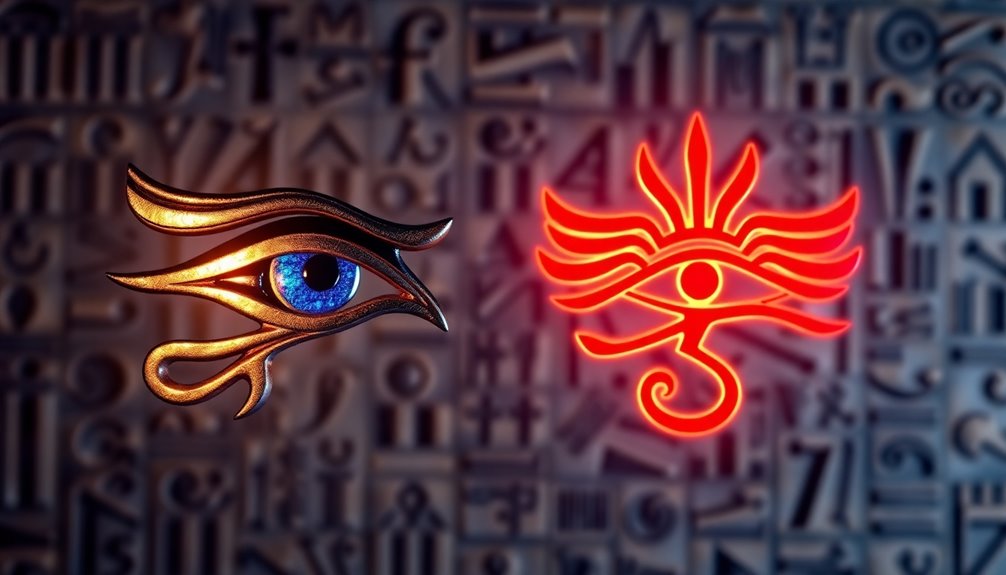Daoism has had a lasting impact on Chinese art, much like a soft breeze moving through a bamboo forest. This influence is evident in the subtle brushwork of Chinese paintings, infusing them with a feeling of simplicity and harmony with nature.
These artworks, rooted in the core values of Daoism, serve as a pathway to spiritual enlightenment, inviting viewers to contemplate the divine and find inner peace. Through the portrayal of nature, the use of calligraphy, and the depiction of Daoist concepts, Chinese art becomes a reflection of the harmony between humans and the natural world.
Key Takeaways
- Daoism heavily influenced various forms of Chinese art, including painting, calligraphy, literature, ceramics, and architecture.
- Chinese art reflects core values of Daoism, such as simplicity and naturalness.
- Daoist art promotes personal growth and inner peace.
- Nature and calligraphy are important elements in Daoist paintings, reflecting the harmony and spiritual oneness with nature.
Daoism and Chinese Art
Chinese art, including painting, calligraphy, literature, ceramics, and architecture, reflects the core values of Daoism. It promotes personal growth and inner peace while conveying the beliefs and teachings of Daoism through symbolism. Calligraphy and symbols are widely used in Chinese paintings, expressing the harmony and energy of nature. Symbols such as yin-yang and the five elements deepen the meaning of the paintings. Daoism heavily influenced Chinese architecture, with buildings designed to harmonize with nature and create tranquility. The integration of Daoist principles in Chinese art and architecture serves as a path to spiritual enlightenment. It allows individuals to contemplate the divine and find inner peace through the appreciation of simplicity, naturalness, and the harmony between humans and nature.
Symbols and Themes
As an art enthusiast, I am captivated by the way symbols and themes in Daoist paintings transport me to a serene state of mind, like a gentle breeze on a warm summer’s day. The use of Daoist symbolism in Chinese art is profound, as it reflects the spiritual oneness with nature that is central to Daoism.
Here are four key aspects of symbolism and themes in Daoist Chinese paintings:
-
Nature as a metaphor: Daoist paintings depict elements of nature such as trees, mountains, water, and animals. However, Chinese painters go beyond capturing the physical appearance of nature. They aim to convey the spirit and essence of nature, encouraging us to contemplate the divine and find harmony within ourselves.
-
Calligraphy as a medium of expression: Calligraphy is an integral part of Daoist Chinese paintings. The brushwork in calligraphy embodies the natural flow of vital energy, expressing the harmony and energy of nature. The placement of symbols in the paintings adds depth and meaning, enhancing the contemplative experience.
-
Yin and yang as a balance: Yin and yang, representing darkness and lightness, femininity and masculinity, respectively, are fundamental concepts in Daoism. Chinese paintings illustrate the interplay of yin and yang through line work, shading, and color. This balance between opposing forces is not only visually appealing but also reflects the cyclical nature of life.
-
The five elements as the foundation: The five elements (Wu Xing) symbolize the balance and harmony in the universe. Traditional Chinese paintings often depict a union between yin and yang, showcasing the cyclical nature of life and the interdependence of the five elements. This portrayal emphasizes the interconnectedness of all things and encourages us to find our own balance within the natural world.
Nature in Paintings
Captivated by the serene beauty it portrays, nature in Daoist paintings transports me to a state of tranquility. The depiction of animals in these artworks serves as a powerful spiritual symbolism. Chinese painters skillfully capture the essence of animals, portraying their natural behaviors and characteristics.
Each animal holds a symbolic meaning, representing different aspects of Daoist philosophy. For example, the crane symbolizes longevity and spiritual transcendence, while the tiger embodies courage and strength. These animals are not merely physical representations, but rather conduits for spiritual enlightenment.
Through their depiction, Daoist paintings invite viewers to contemplate the harmony and interconnectedness between humans and the natural world. The serene landscapes, flowing rivers, and majestic mountains reflect the Daoist belief in the unity of all things. Nature in these paintings becomes a visual representation of the Dao, guiding us towards inner peace and enlightenment.
Calligraphy and Symbols
Immersed in the strokes of calligraphy, I am transported to a realm where symbols dance on the canvas, their energy flowing like the rhythmic movements of a river. The use of brushwork and energy in calligraphy plays a crucial role in Daoist Chinese paintings.
Calligraphy not only expresses the harmony and energy of nature but also embodies the natural flow of vital energy. The symbolism of yin yang and the five elements further deepens the meaning of these paintings.
Yin yang represents the balance between darkness and lightness, femininity and masculinity, which is illustrated through line work, shading, and color. The five elements, serving as the foundation for balance and harmony in the universe, showcase the cyclical nature of life.
The combination of calligraphy and symbols in Daoist Chinese paintings creates a visual language that invites contemplation and a deeper understanding of the divine.
Portrayal of Daoist Concepts
Exploring the portrayal of Daoist concepts in Chinese paintings, I am fascinated by the interplay of yin and yang depicted through line work, shading, and color. Traditional Chinese paintings serve as a visual representation of the balance and harmony between these opposing forces.
Yin, representing darkness and femininity, is often depicted using softer lines and darker shades, while yang, symbolizing lightness and masculinity, is portrayed with bolder lines and brighter colors. This interplay of yin and yang creates a dynamic energy within the artwork, capturing the cyclical nature of life.
Additionally, symbolism plays a significant role in Daoist art, with elements such as the five elements (Wu Xing) and the yin-yang symbol representing the harmony and interconnectedness of the universe. Through these artistic techniques, Daoist concepts are vividly brought to life, inviting viewers to contemplate the deeper meanings within the paintings.
Frequently Asked Questions
How did Daoism influence other forms of Chinese art besides painting?
Daoism had a profound influence on other forms of Chinese art. It shaped sculpture by emphasizing naturalness and simplicity, and ceramics by promoting personal growth and inner peace. Daoist principles infused these art forms with spiritual and contemplative qualities.
What are some specific symbols and themes commonly found in Daoist Chinese paintings?
Symbolic representations, such as yin-yang and the five elements, are commonly found in Daoist Chinese paintings. These paintings utilize artistic techniques like calligraphy and brushwork to convey harmony, balance, and the interplay of nature and humanity.
How do Chinese painters capture the spirit of nature in their artworks?
Chinese painters capture the spirit of nature in their artworks by employing various techniques. They use symbolism to convey the interconnectedness between humans and nature and emphasize the beauty of the natural world, ultimately capturing its essence and natural beauty.
What is the significance of calligraphy and symbols in Daoist Chinese paintings?
The significance of calligraphy and symbols in Daoist Chinese paintings is that they express the harmony and energy of nature. Symbols like yin-yang and the five elements deepen the meaning of the paintings and embody the natural flow of vital energy.
How do yin and yang and the five elements play a role in the portrayal of Daoist concepts in Chinese paintings?
Yin and yang and the five elements play a pivotal role in daoist Chinese paintings. They symbolize balance and harmony, reflecting the interplay between darkness and lightness, femininity and masculinity. Nature and the natural world are also symbolized, promoting a sense of unity and tranquility.
Conclusion
In conclusion, the influence of Daoism on Chinese art is a remarkable journey towards spiritual enlightenment.
Through the use of symbols and themes, Chinese paintings capture the essence of Daoist philosophy, promoting simplicity and naturalness.
The portrayal of nature in these artworks not only showcases its beauty but also highlights the harmony between humans and the natural world.
Calligraphy and symbols further enhance the depiction of Daoist concepts, expressing the energy and harmony of nature.
By exploring these artistic expressions, one embarks on a contemplative path, inviting introspection and a connection with the divine.










